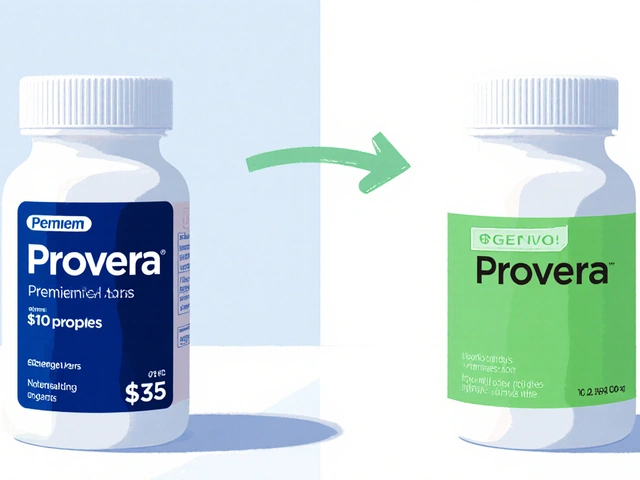Key Takeaways
- About 25% of people on sertraline experience nausea; roughly 10% get diarrhea.
- Eating a bland meal, spacing doses, and using ginger can cut nausea by up to 40%.
- Limiting caffeine, alcohol, and fatty foods speeds diarrhea recovery by about 45%.
- If symptoms persist beyond 2-3 weeks, talk to your doctor about dose reduction or switching antidepressants.
- Persistent watery stools may signal microscopic colitis - a condition that needs specific medical attention.
When you start Sertraline is a selective serotonin reuptake inhibitor (SSRI) prescribed for depression and anxiety, many patients notice an upset stomach. The reality is that sertraline raises serotonin levels not only in the brain but also in the Gastrointestinal tract, which houses about 95% of the body’s serotonin receptors. That extra serotonin speeds up gut motility and fluid secretion, leading to the classic nausea and diarrhea you might be feeling.
Why Sertraline Can Upset Your Stomach
Serotonin is a messenger that tells your intestines to contract and release fluids. When sertraline blocks its re‑uptake, more serotonin stays active in the gut. The result? Faster peristalsis (that’s why diarrhea shows up) and increased gastric secretions (hence nausea). Studies such as Wang et al.’s 2022 network meta‑analysis found sertraline had the highest probability of digestive side effects among five common SSRIs, scoring 0.611 versus 0.548 for fluoxetine.
How Common Are Nausea and Diarrhea?
Clinical trial data and real‑world registries line up on the numbers:
- Approximately 25 % of new sertraline users report nausea within the first two weeks.
- Diarrhea affects at least 10 % of patients, with some studies noting rates as high as 15 % when the dose exceeds 100 mg/day.
- 87 % of those with GI upset see symptoms ease after 4-6 weeks as the body adapts.
Nevertheless, a significant minority (about 18-19 %) stop the medication early because the stomach trouble becomes intolerable.

Dietary Tweaks That Actually Help
Food is your first line of defence. The NHS and several RCTs agree on a handful of simple moves:
- Take sertraline with a full, bland meal - think toast, crackers, or a banana. One 2022 Journal of Clinical Psychiatry study showed a 35‑40 % drop in nausea when patients ate before dosing.
- Snack on ginger. A 2021 trial in the Journal of Psychopharmacology reported a 27 % greater reduction in nausea severity with ginger tea versus placebo.
- Eat smaller, more‑frequent meals instead of three big ones. This steadies gastric emptying and reduces the “full‑stomach” sensation.
- Suck on sugar‑free hard candy or lozenges - the soothing action of saliva can calm the queasy feeling.
For diarrhea, cut down on caffeine, alcohol, and high‑fat or fried foods. A 2020 Gut study found patients who avoided those triggers recovered 45 % faster.
Medication Timing and Dose Adjustments
When diet alone isn’t enough, look at how you’re taking the pill:
- Morning vs. evening: Some people feel less nausea if they take sertraline at night with a snack, allowing sleep to mask early‑day queasiness.
- Start low, go slow: Beginning at 25 mg daily and increasing by 25 mg every 1-2 weeks often eases GI irritation. The American Psychiatric Association’s 2023 guidelines recommend this “titration” approach before considering a switch.
- Split dosing: Dividing the total daily dose into two smaller doses (e.g., 50 mg twice daily) can halve the gut exposure per dose.
If nausea lingers beyond 2-3 weeks despite these tricks, a dose reduction to 25-50 mg is a sensible next step before any medication change.
When to Call Your Doctor
Most GI symptoms settle, but keep an eye out for red flags:
- Diarrhea lasting more than four weeks or that’s watery, bloody, or accompanied by weight loss.
- Severe nausea that prevents you from eating or drinking for more than a couple of days.
- Abdominal pain, fever, or unexplained fatigue.
These could signal microscopic colitis - a form of inflammatory bowel disease linked to sertraline use. Diagnosis requires a colonoscopy with biopsy; treatment may involve stopping sertraline or adding a bowel‑protective agent.

Special Cases: Microscopic Colitis
Microscopic colitis shows up in about 1 % of people on long‑term sertraline, according to the TGA safety update. It presents as chronic watery diarrhea that doesn’t improve with dietary changes. If your doctor suspects it, they’ll likely order stool studies and a colonoscopy. Management typically involves:
- Discontinuing sertraline or switching to an SSRI with a better GI profile (e.g., escitalopram).
- Prescribing budesonide or a similar locally acting steroid to calm gut inflammation.
Most patients see symptom relief within weeks after these steps.
Quick Reference: Management Strategies
| Strategy | How to Apply | Typical Benefit |
|---|---|---|
| Take with food | Consume a bland meal (toast, oatmeal, banana) 30 min before the pill | ↓ nausea 35‑40 % |
| Ginger | Drink 1 cup ginger tea or chew a small piece of raw ginger daily | ↓ nausea 27 % |
| Limit trigger beverages | Avoid coffee, tea, alcohol, and sugary sodas | ↓ diarrhea duration 45 % |
| Small frequent meals | Eat 5-6 small meals instead of 3 large ones | Stabilizes gut motility |
| Dose titration | Start 25 mg daily, increase by 25 mg every 1-2 weeks | Reduces both nausea & diarrhea |
| Medical review | Contact doctor if symptoms >2‑3 weeks or worsening | Prevents complications like microscopic colitis |
Bottom Line
Sertraline’s impact on gut serotonin explains why nausea and diarrhea are common, especially early on. Simple dietary tweaks, smart timing, and gradual dose increases can calm most upset stomachs. Keep a symptom diary, stay hydrated, and know when to seek medical advice - especially if stools become watery or painful. With the right plan, you can stay on sertraline and still feel good.
How long does sertraline‑induced nausea usually last?
Most people notice improvement within 7‑14 days, and 87 % see symptoms ease by the 4‑to‑6‑week mark as the gut adapts.
Can I take an anti‑nausea medication with sertraline?
Yes, short‑term use of ondansetron or dimenhydrinate is generally safe, but always check with your prescriber to avoid drug interactions.
Is it safe to stop sertraline if diarrhea persists?
Abrupt stopping can cause withdrawal symptoms. Discuss a taper plan with your doctor; they may switch you to an SSRI with a milder GI profile.
What is microscopic colitis and how is it linked to sertraline?
Microscopic colitis is an inflammation of the colon that shows up only under a microscope. Studies link long‑term sertraline use with a small increased risk, likely due to serotonin’s effect on the bowel lining.
Should I switch to another antidepressant if I keep getting stomach issues?
If dose titration and lifestyle changes don’t help after 3‑4 weeks, doctors often consider escitalopram or bupropion, which have lower GI side‑effect rates.








Diane Holding October 25, 2025
Hey folks, a quick tip: taking sertraline with a bland snack like toast or a banana can shave off a solid chunk of that nausea. Pair it with a ginger tea and you’ll often notice a steadier stomach within a few days. Keep the meals small and frequent to avoid overloading the gut.
Kevin Stratton October 25, 2025
It’s fascinating how the gut‑brain axis mirrors the internal dialogue of our thoughts – the serotonin surge in the intestines is like an echo of our mental state :) Managing timing and nutrition becomes a small meditation on self‑care. The body appreciates the rhythm.
ALBERT HENDERSHOT JR. October 26, 2025
Indeed, the physiological balance you describe aligns with clinical guidance. A gradual titration-starting at 25 mg and increasing by 25 mg increments-offers a structured pathway to mitigate both nausea and diarrhea. 🙂 Consistency in diet accentuates this effect.
Suzanne Carawan October 26, 2025
Oh great, another list of “simple tricks” that apparently work for everyone. As if swapping coffee for tea is going to fix a pharmacological side effect you signed up for.
Kala Rani October 26, 2025
Try a tiny bite of bread before the pill.
Donal Hinely October 26, 2025
Listen up-big pharma loves to bury the gut‑side effects while they splash cash on glossy ads. If you’re fed up with the corporate narrative, ditch the processed carbs, slap some ginger on that pill, and own your health.
christine badilla October 26, 2025
OMG I’m literally shaking like a leaf every morning! I tried the ginger hack and my stomach finally stopped doing somersaults. It’s like the drama finally ended and I can actually get out of bed without feeling like I’m being tossed by a tornado.
Octavia Clahar October 26, 2025
Nice rundown! The practical steps are spot‑on and easy to follow. I’ve seen friends benefit from the small‑meal approach, so keep the good vibes rolling.
Edward Brown October 26, 2025
What they don’t tell you is that the data on sertraline gut effects is heavily filtered by sponsors the studies are designed to hide the real magnitude of the problem the gut never forgives the brain chemistry overload caused by big pharma
eko lennon October 26, 2025
First, let me say that navigating the side‑effects of sertraline can feel like walking a tightrope over a sea of uncertainty, especially when your stomach decides to stage its own rebellion. You start the medication hopeful, trusting that the mood‑lifting promises will outweigh any inconvenience. Yet within days, the nausea shows up, gnawing at your appetite like an uninvited guest at a dinner party. The key, as the article suggests, is to approach this challenge methodically. Begin with a solid foundation: a bland, low‑fat breakfast that doesn’t provoke the gut. Toast, plain oatmeal, maybe a banana-these are your allies. Next, introduce ginger in a gentle manner; a sip of tea or a small piece of raw root can act as a calming agent for the stomach’s heightened sensitivity. Timing also matters; taking the pill at night can mask early‑day queasiness with sleep, allowing you to awaken with a clearer head. If the nausea persists, consider a slower titration schedule. While many jump straight to 50 mg, starting at 25 mg and moving up in 12‑hour intervals can prevent the gut from being bombarded all at once. When it comes to diarrhea, the article’s advice to limit caffeine, alcohol, and fatty foods cannot be overstated-these substances act as accelerants for intestinal motility. Swapping your morning coffee for herbal tea and opting for lean proteins over fried fare can shorten the duration of watery stools dramatically. Hydration remains essential; sip electrolytes, avoid sugary drinks, and keep a water bottle handy. If symptoms linger beyond three weeks, a conversation with your prescriber becomes crucial. It’s not a sign of weakness but a responsible step toward personalized care. Some clinicians might suggest a dose reduction or a switch to a different SSRI with a more forgiving gastrointestinal profile, such as escitalopram. In rare cases, persistent watery diarrhea could signal microscopic colitis-a condition that demands diagnostic colonoscopy and targeted therapy. Recognizing red flags early can prevent unnecessary suffering and guide appropriate medical intervention. Finally, keep a symptom diary: jot down when you take the medication, what you ate, and how you felt. Patterns emerge, and you’ll be armed with concrete data when discussing options with your doctor. In sum, the journey through sertraline’s side‑effects is navigable with patience, strategic dietary tweaks, and open communication with healthcare providers.
Sunita Basnet October 26, 2025
Optimizing the therapeutic regimen is a synergistic process-by integrating phytogenic ginger extracts with a low‑glycemic breakfast, you create a metabolic buffer that attenuates serotonergic gut hyperactivity. Consistent adherence amplifies the pharmacodynamic synergy.
Melody Barton October 27, 2025
Listen up – if you keep hitting the coffee and greasy stuff you’ll just keep the gut screaming. Cut the junk, stick to bland meals, and you’ll see the nausea drop fast.
Justin Scherer October 27, 2025
Adding a regular hydration schedule and a quick ginger chew after each dose can smooth the transition, especially during the first couple of weeks.
Pamela Clark October 27, 2025
Wow, another “expert” breakdown – as if we needed a PhD to figure out that eating less junk helps. Groundbreaking stuff, truly.
Manish Verma October 27, 2025
Honestly, the best move is to support our local health protocols and stay vigilant about medication side‑effects – it’s part of being a responsible citizen.